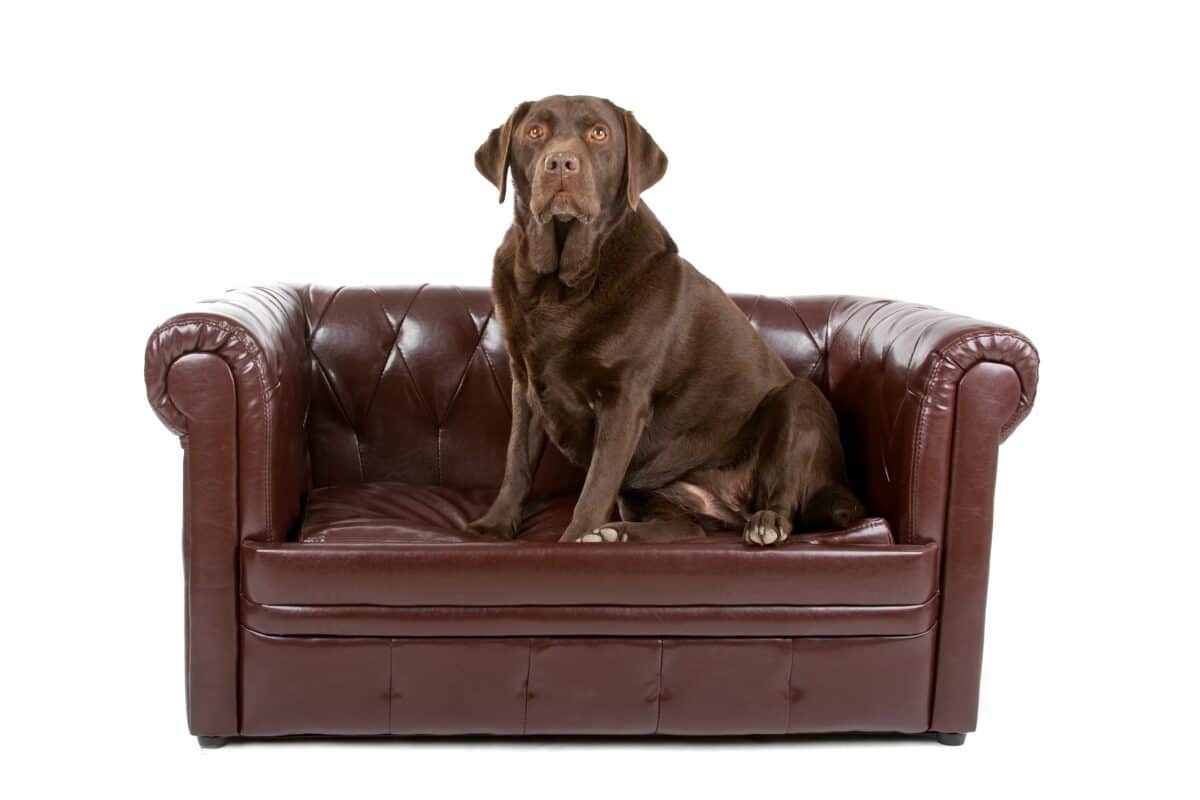Dog on Couch, How to keep a dog off furniture
Dog on Couch? How To Keep a Dog Off Furniture.
Dog on Couch? How to Keep a Dog off Furniture.
Dog on couch? How to keep a dog off furniture By Will Bangura, M.S., CBCC-KA, CPDT-KA, (Dog Behaviorist) Certified Behavior Consultant Canine.
Dogs have been considered man’s best friend for centuries. They have been bred for various purposes, including hunting, herding, and guarding. However, as time has passed, dogs have become more of companion animals, with many people considering them family members. With this change, dogs have increasingly been allowed to have more access to their owners’ spaces, including their furniture. But why do dogs get up on furniture, and what can be done to prevent it? Here are a few of the most common reasons.
Comfort.
It provides them with a comfortable resting place. Furniture is typically soft and cushioned, which makes it an attractive place for dogs to nap.
Height.
Dogs are naturally curious, giving them a higher vantage point from which to survey their surroundings. This can give them a sense of security and comfort, as they can keep an eye on things that are happening around them.
Attention seeking.
Dogs do it to seek attention from their owners. If the owner starts to pet or play with them, they may learn that this is an excellent way to get attention.
Boredom.
Dogs that are left alone for long periods may have boredom. This can be a way for them to relieve their pent-up energy and engage in some form of stimulation.
Lack of Exercise.
Dogs that do not get enough exercise may get up on furniture to burn off energy. This can be especially true for high-energy breeds, such as retrievers and herding dogs.
Anxiety.
Anxious dogs may do it as a way of seeking comfort. This can be a way for them to feel safe and secure in an otherwise stressful environment.
Preventing Dogs from Getting Up on Furniture.
There are several ways to prevent dogs from getting up on furniture. Here are some of the most common methods:
Direct supervision of the dog.
Keeping the dog in sight and under control at all times is the best way to prevent this from happening. This can be done by keeping the dog with you on a leash or by having someone keep an eye on them when you cannot.
Keeping the dog with you on a leash.
Keeping the dog with you on a leash can help prevent them from engaging in this unwanted behavior. This is especially true for dogs that are prone to jumping up on furniture.
Crating or confining the dog when you cannot supervise.
When you cannot directly supervise the dog, you can crate-train your dog or confine them to prevent this behavior from occurring. This can be done in various ways, including using a crate or a gated area.
Barriers and covers.
Another way to prevent this behavior in dogs is to use barriers and covers. This can be done by placing barriers or covers on the furniture, such as a throw blanket or a pet gate. This can help prevent the dog from accessing the furniture and can also protect the furniture from scratches and damage.
Stopping a Dog from Getting on Furniture through Training and Behavior Modification.
Several training and behavior modification techniques can be used to stop this behavior in the future. Here are some of the most common techniques.
Extinction is a training technique that involves ignoring the dog. This means not paying attention to the dog or giving them any form of reinforcement (positive or negative) when they are on the furniture. Over time, the dog should learn that getting up on furniture does not result in any reward, and they should stop doing it.
How to Keep a Dog off Furniture with Positive Reinforcement.
Positive reinforcement is a technique that involves rewarding the dog when they do not get up on furniture. This can be done by giving the dog a treat or praise when they stay off the furniture. Over time, the dog should learn that not getting up on furniture results in a reward, and they should be less likely to do it.
How to Keep a Dog off Furniture with Differential Reinforcement.
Differential reinforcement is a technique that involves rewarding the dog for doing an alternative behavior to getting up on furniture. For example, if the dog usually gets up on the couch, you can reward them for lying on its bed instead. Over time, the dog should learn that lying on their bed results in a reward, and they should be less likely to get up on the couch.
How to Keep a Dog off Furniture with Negative Punishment.
Negative punishment is a technique that involves removing a reward (in this case, you and your attention are the rewards or what the dog wants. when the dog does a behavior, you want to decrease or stop.) For example, you can place them in a crate for a two-minute timeout. Over time, the dog should learn that getting up on furniture results in a negative consequence, and they should be less likely to do it.
Avoiding Positive Punishment to Keep a Dog off Furniture.
Positive punishment is a technique that involves adding an aversive when the dog gets up on furniture. This can include scolding the dog, hitting them, or using an electronic shock collar at a high level. For several reasons, it is essential to avoid using positive punishment as a training technique. First, it can cause the dog to become fearful or aggressive, making the behavior worse. Second, it can damage the bond between the dog and the owner, making it more difficult to train the dog in the future. Instead of using positive punishment, it is recommended to use one of the other techniques, such as extinction, positive reinforcement, differential reinforcement, or negative punishment.
Overcoming Obstacles to Success.
Several obstacles to successfully training a dog to stop this unwanted behavior exist. Here are a few of the most common obstacles.
Accidentally Reinforcing the Behavior.
If the owner accidentally rewards the dog (such as by petting or playing with the dog), the dog will learn that getting up on furniture is good. This can make it more difficult to train the dog to stay off the furniture in the future.
Getting Up on the Furniture with Attention.
If the owner gets up on the furniture with their attention (such as by sitting on the couch and watching TV), the dog may think it is okay to get up on it. This can make it more difficult to train the dog to stay off the furniture in the future.
Lack of Consistency.
If the owner is inconsistent with their training, the dog may become confused, and the training will not be as effective. The owner needs to be consistent in their training, using the same technique each time and rewarding the dog for not getting up on furniture every time they stay off.
In conclusion, there are many reasons why dogs may get up on furniture, and several techniques can be used to prevent or stop the behavior. Some of the most common techniques include direct supervision, keeping the dog on a leash, using barriers or covers, and training and behavior modification techniques such as extinction, positive reinforcement, differential reinforcement, and negative punishment. It is essential to avoid using positive punishment and to be aware of the common obstacles to success, such as accidentally reinforcing the behavior with attention and lack of consistency in training. By using the proper techniques and overcoming obstacles, it is possible to train a dog to stay off the furniture successfully. You may need to consult a dog behaviorist or trainer in some more difficult cases.
References.
- American Kennel Club. (2021). Training Tips: Furniture and Dogs. Retrieved from https://www.akc.org/expert-advice/training/training-tips-furniture-and-dogs/
- Battenfeld, J. (2020). Positive Reinforcement Training for Dogs: Everything You Need to Know. Retrieved from https://www.akc.org/expert-advice/training/positive-reinforcement-training-for-dogs/
- ASPCA. (2021). Training Techniques: Positive Reinforcement. Retrieved from https://www.aspca.org/animal-homelessness/shelter-medicine/training-techniques-positive-reinforcement
- Association of Pet Dog Trainers. (2021). Differential Reinforcement. Retrieved from https://apdt.com/pet-owner-resources/training-techniques/differential-reinforcement/
- PetMD. (2021). Training Dogs to Stay Off Furniture. Retrieved from https://www.petmd.com/dog/training/evr_dg_training_dogs_to_stay_off_furniture
- The Humane Society of the United States. (2021). Extinction. Retrieved from https://www.humanesociety.org/resources/extinction
- The Spruce Pets. (2021). How to Stop a Dog from Jumping on Furniture. Retrieved from https://www.thesprucepets.com/how-to-stop-a-dog-from-jumping-on-furniture-4688613


